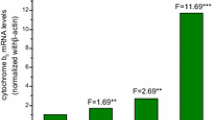Abstract
Primary cultures of chick embryo hepatocytes are known to maintain their initial level of cytochrome P-450 for a number of days. To explore the possibilities of chick embryo hepatocyte cultures as a tool in drug metabolism, induction profiles of cytochrome P-450 were determined and the metabolism of benzo(a)pyrene as a model substrate was studied.
Maximum induction by phenobarbitone and Aroclor 1254 is reached after 21 h and 18 h, respectively, both in the presence and absence of serum. For β-naphthoflavone induction is maximal after 31 h in the presence and 43 h in the absence of serum. The levels of P-450 after induction are comparable to those found in vivo in rats: increases of 200% for phenobarbitone, 200% for β-naphthoflavone and 210% for Aroclor 1254. Ethoxyresorufin-0-deethylase activities are induced by β-naphthoflavone and Aroclor 1254, but as expected only slightly by phenobarbitone. In the absence of serum in the culture medium, for the control as well as the induced cells a plateau of activity is maintained for at least 24 h. In the presence of serum a decline in P-450 levels is observed. Especially in the case of Aroclor, an increase in porphyrin content of 320% of control values is seen at the same time.
A number of representative metabolites of benzo(a)pyrene were quantitated during a 4-h incubation. Relative amounts are comparable to those observed with rat liver microsomes. As expected, β-naphthoflavone and Aroclor induce the rate of metabolism (by 500% and 400%, respectively, in the absence of serum), but phenobarbitone has no or very little effect.
Interestingly, when benzo(a)pyrene is incubated with control or phenobarbitone-induced cells an increase in rate of metabolite formation with time is observed: benzo (a)pyrene seems to induce its own metabolism. The chick embryo hepatocytes thus offer the possibility of studying induction and biotransformation in the same system at the same time, in vitro.
Similar content being viewed by others
References
Althaus FR, Sinclair JF, Sinclair PR, Meyer UA (1979) Drug-mediated induction of cytochrome(s) P-450 and drug metabolism in cultured hepatocytes maintained in chemically defined medium. J Biol Chem 25: 2148–2153
Bridges JW, Fry JR (1977) Drug metabolism in cell suspension and cultures. In: Parke DV, Smith RL (eds) Drug metabolism: from microbe to man, Taylor & Francis, London, NY pp 43–54
Burke MO, Vadi H, Jernström B, Orrenius S (1977) Metabolism of benzo(a)pyrene with isolated hepatocytes and the formation and degradation of DNA-binding derivatives. J Biol Chem 252: 6424–6431
Debets FMH, Hamers WHGMB, Strik JJTWA (1980) Metabolism as a prerequisite for the porphyrinogenic action of polyhalogenated aromatics, with special reference to hexachlorobenzene and polybrominated biphenyls. Int J Biochem 12: 1019–1024
Giger U, Meyer A (1981) Induction of δ-Aminolevulinate synthase and cytochrome P-450 hemoproteins in hepatocytes culture. J Biol Chem 256: 11182–11190
Quillouzo A, Begne JM, Campion JP, Gascoin MN, Quillonzo-Guguen C (1985) Human hepatocyte cultures: a model of pharmacotoxicological studies. Xenobiotica 15: 634–641
Holme JA, Søderlund E, Dybind E (1983) Drug metabolism activities of isolated rat hepatocytes in monolayer culture. Acta Pharmacol Toxicol 52: 348–356
Jongen WMF, Topp RJ, Tiedink HGM, Brink EJ (1986) A co-cultivation system as a model for in vitro studies of modulating effects of naturally occurring indoles on the genotoxicity of model compounds. Fd Chem Toxicol (in press)
Jongeneelen FJ, Leijdekkers ChM, Bos RP, Theuws JLG, Henderson PTh (1985) Excretion of 3-hydroxy-benzo(a)pyrene and mutagenicity in rat urine after exposure to benzo(a)pyrene. J Appl Toxicol 5: 277–282
Lowry OH, Rosebrough MJ, Fass AL, Randall RJ (1951) Protein measurement with the Folin phenol reagent. J Biol Chem 183: 265–275
Malansky CJ, Williams GM (1982) Primary cultures and the levels of cytochrome P-450 in hepatocytes from mouse, rat hamster and rabbit liver. In Vitro 18: 683–693
Omura T, Sato R (1964) The carbon monoxide-binding pigment of liver microsomes. J Biol Chem 239: 2370–2378
Paine AJ (1980) The maintenance of cytochrome P-450 in liver cells culture: A prerequisite to the study of drug metabolism and toxicity. Atla Abstracts 8: 86–91
Prough RA, Burke MO, Mayer RT (1978) Direct fluorometric methods for measuring mixed function oxidase activity. In: Colowick SP (ed) Methods in enzymology Vol. L 11 Academic Press, New York San Fransisco London, pp 372–377
Sassa S, Kappas A (1977) Induction of δ-Aminolevulinate synthetase and porphyrins in cultured liver cells maintained in chemically defined medium. J Biol Chem 252: 2428–2436
Sinclair JF, Sinclair PR, Bonkowsky ML (1979) Hormonal requirements for the induction of cytochrome P-450 in hepatocytes cultured in a serum-free medium. Biochem Biophys Res Commun 86: 710–717
Sirica AE, Pitot HC (1980) Drug metabolism and effects of carcinogens in cultured hepatic cells. Pharmacol Rev 31: 205–228
Thakker DR, Yagi M, Jerina DM (1978) Analysis of polycyclic aromatic hydrocarbons and their metabolites by high pressure liquid chromatography In: Colowick SP (ed) Methods in enzymology Vol. L11 Academic Press, New York San Francisco London, pp 279–296
Author information
Authors and Affiliations
Rights and permissions
About this article
Cite this article
Topp, R.J., van Bladeren, P.J. Oxidative biotransformation in primary cultures of chick embryo hepatocytes: induction of cytochrome P-450 and the metabolism of benzo(a)pyrene. Arch Toxicol 59, 150–155 (1986). https://doi.org/10.1007/BF00316324
Received:
Accepted:
Issue Date:
DOI: https://doi.org/10.1007/BF00316324



